<< Previous | Displaying results 4326-4350 of 6769 for "" | Next >>
Most Polish Jewish refugees stayed in Japan much longer than their 10-day transit visas allowed. Many feared the day when Japanese authorities would no longer extend their stay with permits like the one shown here. [From the USHMM special exhibition Flight and Rescue.]
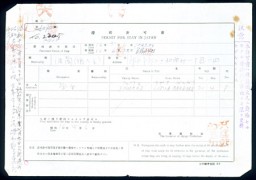
Japanese authorities issued this "Permit for stay in Japan" to Ruth Segal (Rys Berkowicz). After several unsuccessful attempts to obtain visas for the United States, Ruth's father was able to secure a visa for her to go to New Zealand, in the British Commonwealth of Nations. [From the USHMM special exhibition Flight and Rescue.]
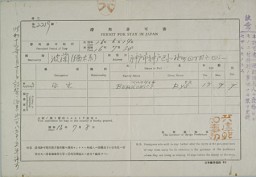
Family and friends of Ruth Segal (Rys Berkowicz) sent this postcard to her in Kobe, Japan. They sent the postcard from Warsaw, in German-occupied Poland, on June 20, 1941. [From the USHMM special exhibition Flight and Rescue.]
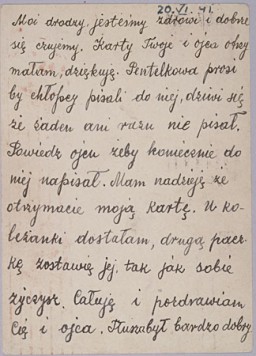
Protective document issued to a Jewish woman by the Swedish embassy in Budapest, Hungary, in 1944. Such documents protected the bearer from immediate deportation by the Germans to the Auschwitz killing center in occupied Poland. The "W" in the lower left corner indicates that Raoul Wallenberg initialed the document.
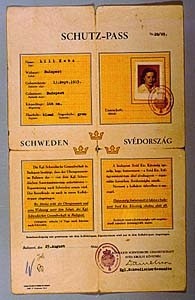
A second RCA Radiogram telegram from Rabbi Grodzenski, Chief Rabbi of Vilna, to the Central Relief Committee in New York. He requests aid for refugees who have gathered in Vilna. The telegram says that more than 1,600 yeshiva students and their families from over 10 cities throughout Poland have fled to Vilna, where they remain in terrible living conditions. November 5, 1939. [From the USHMM special exhibition Flight and Rescue.]
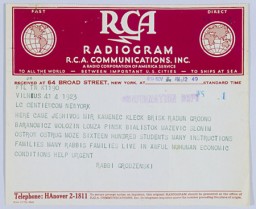
Many refugees had difficulties replacing lost or invalidated personal identification documents. The certificate of Polish citizenship shown here was valid in place of a passport. A Polish Jewish refugee used this certificate to travel legally from Lithuania, through the Soviet Union, to Japan. It contains the Curacao notation needed to obtain Soviet and Japanese visas. The bearer of this certificate aimed to reach Palestine, but ended up spending most of the war in Calcutta, India, part of the British…
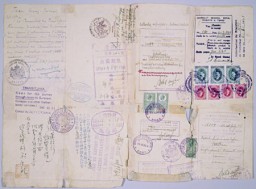
Setty and Moritz Sondheimer and their two children fled Nazi Germany for Kovno, Lithuania, in 1934. There, Moritz opened a small factory manufacturing buttons and combs. This image shows page 2, containing an identification photograph, of a passport issued to Setty Sondheimer by the German Consulate in Kovno on January 29, 1938. With aid from Japanese diplomat Chiune Sugihara in obtaining Japanese transit visas, Setty and her family emigrated from Kovno in February 1941. [From the USHMM special exhibition…
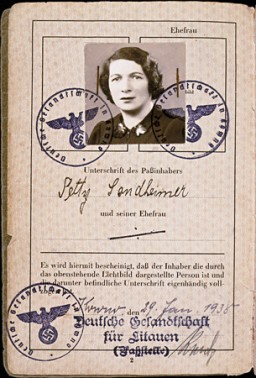
Page 5 of a passport issued to Setty Sondheimer by the German Consulate in Kovno on January 29, 1938. This page contains three visas: (1) visa for Kovno valid from August 27, 1940, until December 31, 1940 (2) a second visa for Kovno valid until June 30, 1941, and (3) first visa for Yokohama, Japan, valid from June 7, 1941, until June 30, 1942. Unable to emigrate from Japan, Setty remained there until she was able to emigrate to the United States in 1947. [From the USHMM special exhibition Flight and…

Transit visa in a passport issued to Setty Sondheimer, a German citizen. This visa, issued on August 6, 1940, enabled her to travel through Japan en route to Surinam, Curacao, or other Dutch colonies in the Americas. These plans were disrupted when travel across the Pacific Ocean was forbidden following U.S. entry into World War II. Setty remained in Japan until she was able to emigrate to the United States in 1947. [From the USHMM special exhibition Flight and Rescue.]
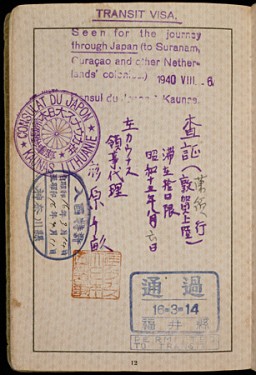
The Soviet travel agency Intourist issued this type of luggage tag, showing a route map, to passengers on the Trans-Siberian Express. Some Jewish refugees traveled on the Trans-Siberian Express as they fled eastward. [From the USHMM special exhibition Flight and Rescue.]
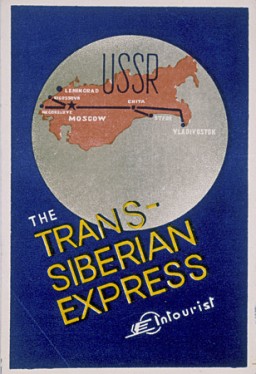
A Jewish refugee purchased this postcard of the Lenin Library during a stopover in Moscow. Soviet Union, 1940-1941. [From the USHMM special exhibition Flight and Rescue.]
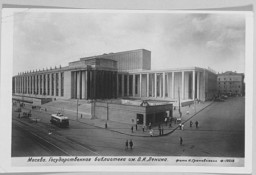
A train ticket for travel on the Trans-Siberian Railroad. [From the USHMM special exhibition Flight and Rescue.]
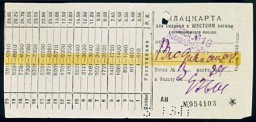
Voucher for travel on the Trans-Siberian Railroad purchased at the "Intourist Travel Company of the USSR" in England for Joseph and Ruth Schaffer. Thousands of Jewish refugees fled Nazi Europe on the Trans-Siberian Railroad through the Soviet Union to Japan with the help of Japanese visas provided by Japanese diplomat Chiune Sugihara. [From the USHMM special exhibition Flight and Rescue.]
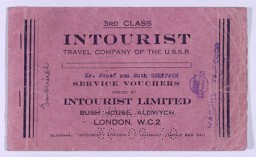
Soviet authorities issued this receipt, in Russian, to Moshe Zupnik for the rubles they confiscated from him before he left the Soviet Union. Soviet authorities routinely confiscated most rubles and other valuables from Jewish refugees before they boarded steamers bound for Japan and left the Soviet Union. Vladivostok, Soviet Union, January 22, 1941. [From the USHMM special exhibition Flight and Rescue.]
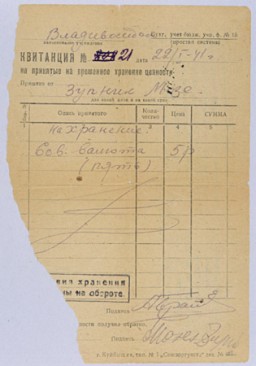
A page in a passport belonging to Setty Sondheimer containing stamps from Ecuador. These stamps are marked in red with the word "Anulado," the Spanish word for "canceled." The stamps were canceled when Setty's visa for Ecuador expired because she was unable to travel across the Pacific due to fighting in that theater. Setty remained in Japan for the duration of the war and emigrated to the United States in 1947. [From the USHMM special exhibition Flight and Rescue.]
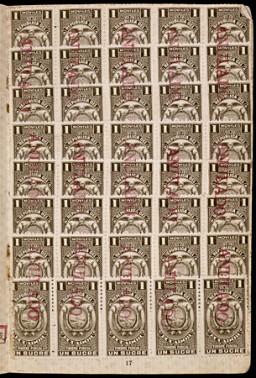
Proclamation issued on February 18, 1943, by the Imperial Japanese Army and Navy authorities establishing, for reasons of "military necessity," a "designated area" for "stateless refugees" in the Hongkew area of the International Settlement. [From the USHMM special exhibition Flight and Rescue.]
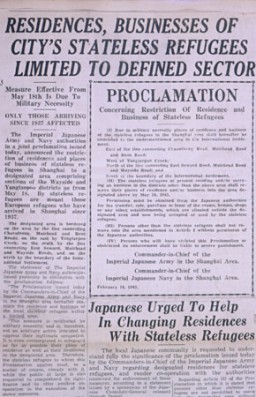
Polish-language newspaper for refugees in Shanghai: Wiadomosci, "News for War Refugees in Shanghai." [From the USHMM special exhibition Flight and Rescue.]
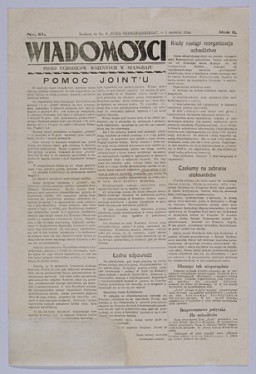
Announcement dropped by American planes on Shanghai near the end of the war. [From the USHMM special exhibition Flight and Rescue.]
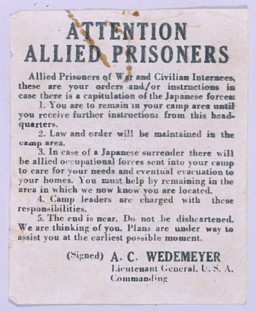
Newspaper Our Life, for September 7, 1945, showing the headline "Long Live Allied Victory". [From the USHMM special exhibition Flight and Rescue.]
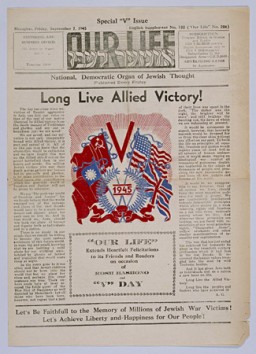
Yiddishe Shtime fun Vaytn Mizrekh (Jewish Voice of the Far East), Shanghai, December 1945. Includes black border notice of 5,700,000 Jewish victims. [From the USHMM special exhibition Flight and Rescue.]
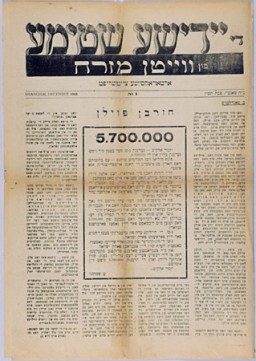
Polish citizenship certificate issued to Samuel Solc on December 16, 1939, by the Britannic Majesty's Legation in Kovno, charged with representing Polish interests in Lithuania. Samuel decided to emigrate to Palestine in late 1939. His journey lasted over two years and took him through eight countries. Samuel arrived in Palestine on February 6, 1942, after stays in Lithuania; Kobe, Japan; Shanghai, China; and Bombay, India. [From the USHMM special exhibition Flight and Rescue.]
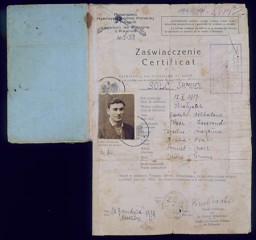
This page of a Polish citizenship certificate issued to Samuel Solc contains two visas. The first (left), stamped by the British Passport control in Shanghai, allowed Samuel to travel to Palestine via Burma, India, Egypt, and Rangoon. The second visa (right) bears the British Mandate "Government of Palestine" stamp, dated February 6, 1942, and allowed Samuel to remain in Palestine permanently. [From the USHMM special exhibition Flight and Rescue.]

A Lithuanian safe conduct pass bearing a stamp for transit through Japan (from Chiune Sugihara), two Soviet transit visas, a Lithuanian stamp, a U.S. non-immigrant visa, and a U.S. entry stamp from Seattle, Washington. [From the USHMM special exhibition Flight and Rescue.]

Diagram showing "the web of communications" between Japanese diplomats and members of the Polish resistance in the Baltic states and Scandinavia. The "Konsulat japonski Kowno" refers to Sugihara. Despite its ties with Nazi Germany, Japan pursued its own course in foreign policy. After the Germans occupied Poland and the Netherlands, Japan continued relations with both the Polish and Dutch governments-in-exile in London. July 1940.
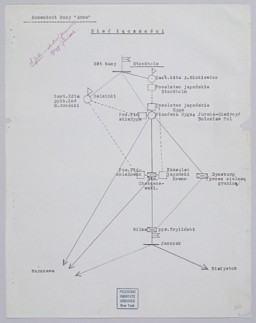
This cartoon, “The Modern Mercury” by Jerry Doyle, appeared in The Philadelphia Record, December 7, 1935. The faded large figure in the background bears the label “Olympics ideals of sportsmanship and international good will.” The image of Hitler in the foreground bears the words “1936 Olympics,” “Intolerance and discrimination,” and “Nazism.”
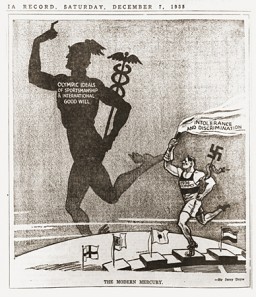
We would like to thank Crown Family Philanthropies, Abe and Ida Cooper Foundation, the Claims Conference, EVZ, and BMF for supporting the ongoing work to create content and resources for the Holocaust Encyclopedia. View the list of donor acknowledgement.